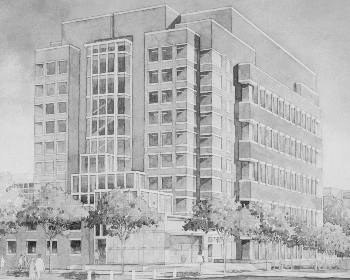
 |
Hopkins Breaks
|

Johns Hopkins Medicine leaders broke ground last week for a state-of-the-art cancer research building at a site on the East Baltimore medical campus opposite The Johns Hopkins Hospital. Federal and state officials, including Sens. Paul Sarbanes and Barbara Mikulski and Reps. Benjamin Cardin and Elijah Cummings, took part in the ceremony. Baltimore Orioles player and cancer survivor Eric Davis, unable to attend in person, delivered a pre-recorded video message. "This occasion truly is a celebration of Hopkins' commitment to finding a cure for cancer," said Martin D. Abeloff, director of the Johns Hopkins Oncology Center. "Such an investment in the future of cancer research, particularly in an economic climate where few academic institutions are willing to dedicate resources for such a facility, is incredibly gratifying." The new building is expected to eliminate overcrowding in existing laboratories, modernize lab equipment and other research tools and enhance cancer research by bringing together scientists from disparate parts of the Hopkins medical campus in one physically integrated research and teaching facility. "No longer can cancer research be conducted in isolation. What is learned by the molecular biologist, the oncologist, the surgeon and the nurse must be shared if we are to spend research dollars wisely and leverage knowledge quickly to benefit our patients," said Edward D. Miller, dean of the medical faculty and CEO of Johns Hopkins Medicine. "In recent weeks, Hopkins scientists have made headlines around the world with their research into the causes, cure and prevention of cancer. This new building should stimulate even greater achievement." "The need for a new facility arises out of our success," said Stephen Baylin, associate director for research at the Oncology Center. "Advances in cancer genetics, gene therapy and other areas of cancer research have increased exponentially. Our cancer researchers are among the most talented and dedicated in the country, if not the world, and enhancing the environment in which they work will lead to greater discovery." Baylin also sees the facility as a critical step toward recruiting new faculty and cultivating the careers of young research fellows. The cancer research building is a companion structure to a new clinical cancer facility, the Harry and Jeanette Weinberg Building, currently under construction directly across Broadway, next to the hospital, and scheduled to open in the spring of 1999. The close proximity of the two buildings is intended to stimulate interaction between those conducting basic science research, clinical research and patient care. The new research facility will house programs in cancer biology, hematological malignancies such as leukemia and lymphoma, urological oncology, gastrointestinal cancer, solid tumor research, pharmacology and experimental therapeutics, and cancer prevention and control. Increased open space, break rooms, conference facilities and shared research support areas were incorporated into the plans to foster new collaborations and research activities among scientists, a chief aim of the design team and the Hopkins collaborators. The architects also employed a unique interstitial design that allows for space above the laboratories to accommodate utilities and other electronics while enabling repairs and electronic equipment upgrades to be made without any disruption of activity in the lab facility below. The additional floor-to-floor height in the laboratory core means that there will be two floors of office space for every one floor of dedicated laboratory space, resulting in 10 stories of office space at each end of the building with five stories of laboratories in between. Estimated to cost $59 million, the new cancer research building is expected to open in late 1999. In an effort to address the high rates of cancer in Maryland, which has ranked among the top five states in cancer death rates for the past 40 years, the state has committed funds for this building. Other funding for the facility will come from the National Cancer Institute, private philanthropy and other institutional resource allocations.
Go back to Previous Page
|